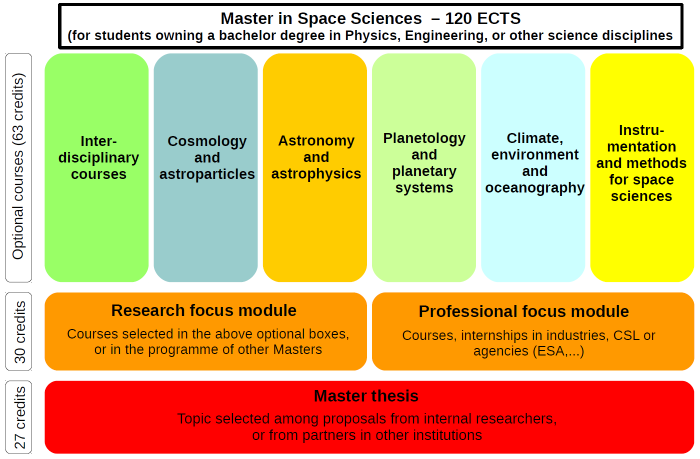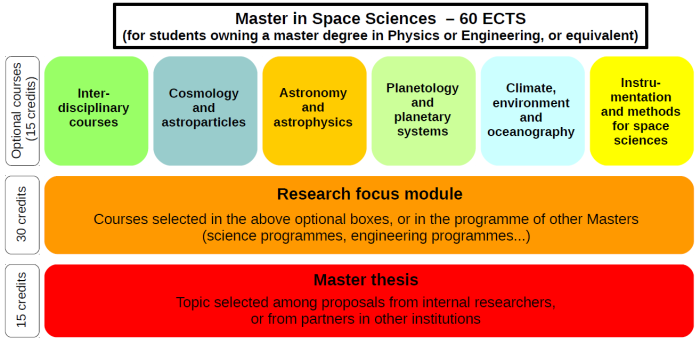 Uniquement en anglais...
Uniquement en anglais...- AGO Department
- Master
in Space Sciences - Admission
- Organization
- Teachers
- Programme
- Courses schedule
- Master thesis
- Facilities
- Mobility opportunities
- Employment prospects
de Géophysique (Bât. B5c)
Quartier Agora
Allée du 6 août, 19C
B-4000 Liège 1 (Sart-Tilman)
Belgique
Tel.: 04.366.9779
Fax: 04.366.9729
Master in Space Sciences
Programme
The 2-year master consists of 120 credits and the 1-year version consists of 60 credits. These credits have to be selected from a programme containing more than 225 credit, covering topics such as cosmology, astroparticles, astrophysics, planetology, climate, oceanography and techniques related to ground-based and space-borne facilities.
Master in 120 credits (2-year)
During the first year, students must choose 60 credits among the proposed optional courses. These are sorted in 6 categories, as illustrated by the upper boxes in the chart below. To guarantee the coherence of the programme and avoid over-specialization, two courses have been flagged as semi-mandatory and every student has to choose at least one of them in 5 out of the 6 categories. Finally, students will have to take into account the co-requisites of the chosen courses, as some courses are the continuation of others. The detailed list of courses along with their co-requisites can be consulted in the official programme.

The research-focus orientation of the Master in Space Sciences is reinforced during the second year by a 30-credit module taken during the second year. In addition to the courses included in the six categories specific to this master, students are allowed to select courses from other masters (Space Engineering, Geomatics, Computer Sciences...) to complete their training. Courses from other institutions may also be considered, provided that these choices are motivated by a consistent training prgramme validated by the Board of examiners.
The professional-focus orientation is fed with courses reinforcing the preparation of students for non-academic careers. It includes an internship allowing an immersion in a private company, in the Centre Spatial de Liège, or potentially a space agency. In the context of this orientation, students have also the opportunity to value the participation in external activities, including for instance course sessions organized by the European Space Agency in Redu (Belgium).
Finally, during the second year of studies, students must prepare a Master thesis worth 27 credits. The thesis must be original and has to meet the criteria set by the Board of examiners. Details about the Master thesis can be found here.
To sum up, students must choose their courses according to:- the presence of at least one semi-mandatory course in each category,
- the inclusion of co-requisites,
- the schedule presented here,
- and, of course, their own preferences.
Master in 60 credits (1-year)
The lightened version of the Master in Space Sciences is only accessible to students already owning a master degree in Physics or Engineering, or any equivalent degree (conditions for admission). The 1-year version offers a complementary educational programme covering some aspects of the 2-year version. Students have to choose at least one semi-mandatory course in three out of the six categories defined above. The master thesis worth 15 credits must also be prepared and defended by the students, according to criteria set by the board of examiners.





